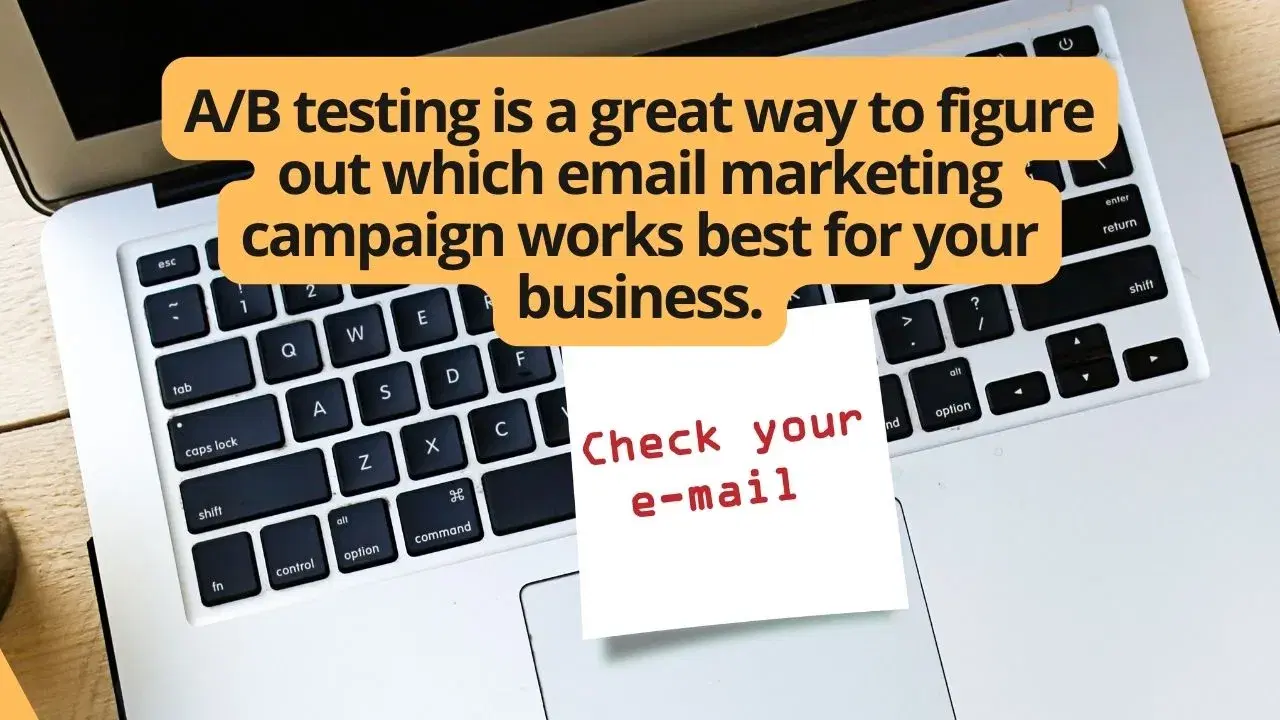
As an email marketer, I've learned that the key to success lies in continual optimization and refinement. One of the most effective tools in my arsenal is A/B testing. It's a technique that has transformed my email campaigns, boosting open rates, click-through rates, and ultimately, conversions.
I remember when I first started out in email marketing. I would craft what I thought was the perfect email, send it out to my entire list, and then wait with bated breath for the results. More often than not, I was disappointed. My open rates were low, and click-throughs were even lower. I knew I needed to do something different.
That's when I discovered A/B testing for email marketing campaigns. It was a revelation. Instead of sending one version of an email and hoping for the best, I could test two different versions and let the data guide my decisions.
So, what exactly is A/B testing? In simple terms, it's a method of comparing two versions of an email campaign to determine which one performs better. These versions can differ in terms of subject line, content, layout, call-to-action, or any other element. By sending these two versions to a small subset of your email list and measuring the results, you can determine which version resonates better with your audience.
The benefits of A/B testing in email marketing are clear. It takes the guesswork out of email optimization. Instead of relying on intuition or assumptions, you can make data-driven decisions. This leads to higher engagement, more clicks, and ultimately, more conversions.
But how do you actually set up A/B testing for email? The first step is to determine what you want to test. This could be the subject line, the email content, the call-to-action, or even the sender name. Once you've decided on the element to test, you create two versions of your email, differing only in that one element.
Next, you select a small portion of your email list to be your test group. This group is then split into two, with each half receiving one version of the email. The rest of your list, the control group, receives the version that you would normally send without testing.
After the emails are sent, you monitor the performance of each version. Most email marketing platforms provide detailed analytics, allowing you to track open rates, click-through rates, and other key metrics. Based on this data, you can determine the winner of your A/B test.
But the process doesn't end there. Analyzing A/B testing results is crucial for informing your future email campaigns. Look for patterns and insights. If a particular subject line style consistently outperforms others, incorporate that into your future campaigns. If a certain call-to-action consistently gets more clicks, use that as your default.
Of course, there are best practices for A/B testing emails that can help ensure your tests are effective. First and foremost, only test one element at a time. If you change multiple elements between your two versions, you won't know which change caused any differences in performance.
It's also important to ensure your sample size is large enough to provide statistically significant results. A very small sample size can lead to skewed results that don't reflect the preferences of your overall email list.
Another key best practice is to give your tests enough time to run. Don't jump to conclusions based on the results of a test that only ran for a few hours. Give each test at least 24 hours, if not longer, to ensure you're capturing a representative sample of your audience's behavior.
Despite the clear benefits of A/B testing, many email marketers still aren't using this technique. In my experience, this is often due to a few common mistakes in A/B testing emails.
One of the most common mistakes is testing too many elements at once. As mentioned earlier, this makes it impossible to know which change caused any difference in performance. Stick to testing one element at a time for clear, actionable insights.
Another mistake is not having a clear hypothesis before running a test. A/B testing shouldn't be a shot in the dark. Before each test, you should have a clear idea of what you expect the results to show. This helps guide your analysis and ensures you're learning from each test.
Finally, some marketers make the mistake of not following through on their test results. If a particular version of an email outperforms the other, use that information! Implement the winning version in future campaigns.
When it comes to measuring results from A/B testing, the most important metrics to track are open rates, click-through rates, and conversion rates. Open rates tell you how effective your subject lines are at enticing people to actually open your emails. Click-through rates show how engaging your email content and calls-to-action are. And conversion rates, whether that's sales, sign-ups, or another desired action, are the ultimate measure of an email campaign's success.
One of the most powerful applications of A/B testing is improving conversion rates through A/B testing. By continually testing and refining every element of your emails, you can create campaigns that are finely tuned to your audience's preferences. This leads to more engagement, more clicks, and ultimately, more conversions.
For example, let's say you run an e-commerce store and you're using email marketing to drive sales. You could use A/B testing to optimize every step of your email funnel. Test different subject lines to improve open rates. Test different product images and descriptions to improve click-through rates. And test different offers and calls-to-action to improve conversion rates.
One element of email marketing that's particularly ripe for A/B testing is the subject line. The subject line is often the first thing a recipient sees, and it plays a huge role in whether they open the email or not. A/B testing subject lines for better open rates is a strategy that every email marketer should be using.
When testing subject lines, try different lengths, different tones (e.g., casual vs. formal), and different value propositions. See what resonates with your audience. Do they respond better to subject lines that are short and punchy, or longer and more descriptive? Do they prefer a friendly, conversational tone, or a more professional one? Do they open emails that offer discounts more often than emails that offer content?
These are the kinds of insights that effective A/B testing strategies for email marketing can provide. By continually testing and learning, you can create email campaigns that truly resonate with your audience.
Of course, even with A/B testing, not every email will be a home run. There will be tests where neither version performs particularly well. But that's okay. In fact, it's expected. The point of A/B testing isn't to find the perfect email, but to continually learn and improve.
One of the benefits of A/B testing is that it allows you to take risks and try new things. Want to test a completely new email design? Go for it. Want to try a subject line that's way outside your usual style? Give it a shot. With A/B testing, you can experiment without fear, because you're always testing against a proven control.
Decide what you want to test. This could be anything from the subject line to the call to action.
Create two versions of your email - each with a different element that you're testing.
Send both versions to a small group of subscribers (ideally around 100-200 people).
Monitor the results and see which version performs better.
Send the winning version to your entire list.
In conclusion, A/B testing is a powerful tool that every email marketer should be using. By continually testing and refining your campaigns, you can improve open rates, click-through rates, and conversion rates. You can take the guesswork out of email marketing and make data-driven decisions that resonates with your audience.
So if you're not already using A/B testing, start today. Pick one element of your emails to test, set up your test, and let the data guide you. It may take some time and effort to get started, but the results are worth it. With A/B testing, you can take your email marketing to the next level and achieve the results you've always dreamed of.
References:
1- Kohavi, R., & Longbotham, R. (2017). Online Controlled Experiments and A/B Testing. In Encyclopedia of Machine Learning and Data Mining (pp. 922-929). Springer US.
2- Nielsen, J. (2005). Putting A/B Testing in Its Place. Usability Engineering, 1-11.
3- Siroker, D., & Koomen, P. (2013). A/B testing: The most powerful way to turn clicks into customers. John Wiley & Sons.
4- Ash, T., Page, R., & Ginty, M. (2012). Landing page optimization: The definitive guide to testing and tuning for conversions. John Wiley & Sons.
Test one element at a time. This will help you isolate the impact of each element on your results.
Be patient. It can take a few rounds of testing to see significant improvements in your outcomes.
Be systematic. Plan out each test in advance to track your progress and measure your results accurately.
Keep learning. As you gain more experience with A/B testing, you'll learn what works best for your business and your customers. By continuously testing and refining your approach, you can keep improving the performance of your email marketing campaigns.
It's necessary to be patient and give each test enough time to run its course. Rushing things will only lead to inaccurate results.
Make sure you're testing different elements of your emails, such as the subject line, content, call to action, or sender name. Trying various factors will help you identify which features are most important to your subscribers.
Don't forget to analyze your results and make changes based on what you've learned.
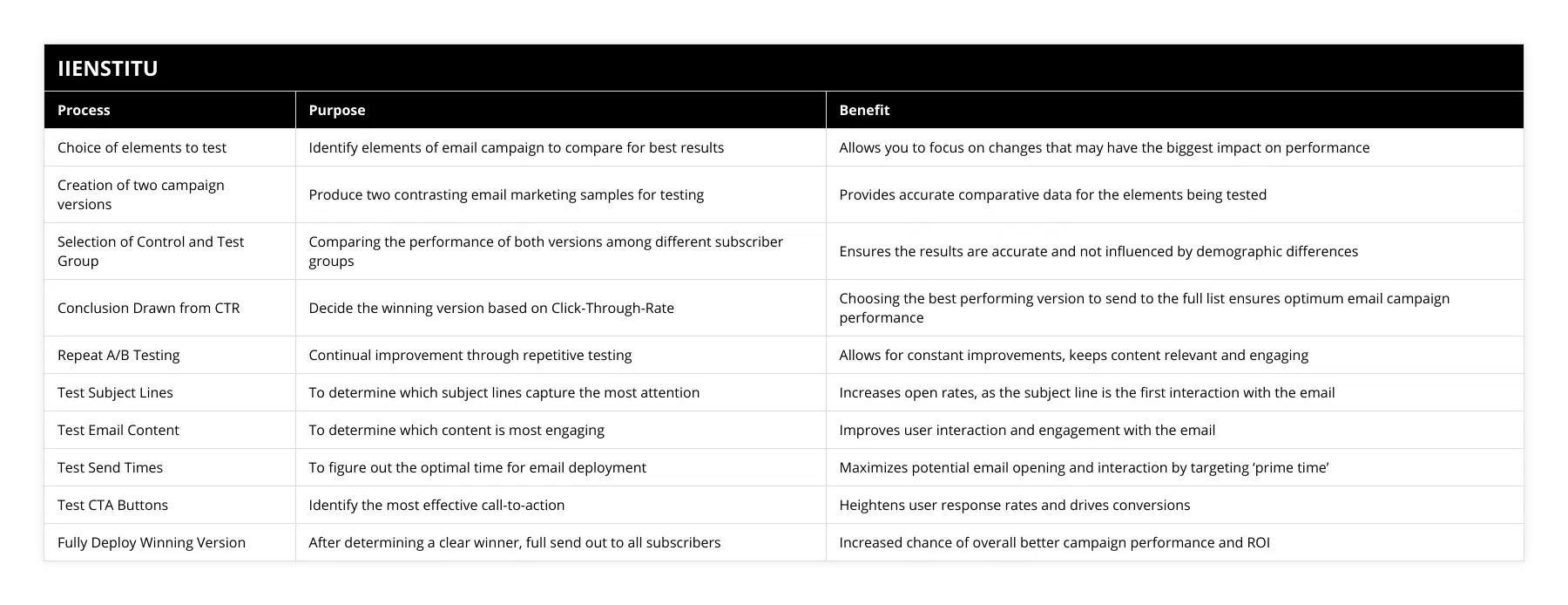
Frequently Asked Questions
How can you do an A/B test for your email marketing campaigns?
Answer: You can do an A/B test for your email marketing campaigns by creating two different versions of your campaign—A and B. Send version A to a small percentage of your subscribers, and send version B to the rest of your subscribers.
Then, track the results of each campaign (opens, clicks, conversions, etc.) to see which version performed better. This will help you determine which type of email campaign is more effective for your audience.
What are some of the risks of not doing an A/B test for your email marketing campaigns?
Not doing an A/B test for your email marketing campaign can lead to a number of risks, including:
-You could be missing out on potential conversions and sales.
-You may not be targeting the right audience with your messaging.
-Your email may not be formatted correctly, which could lead to lower engagement rates.
-You could be wasting time and money on ineffective campaigns.
To avoid these risks, it's important to test different elements of your email marketing campaign to see what works best for your audience. A good digital marketing course will teach you how to do this effectively.
How can you ensure that your email marketing campaigns are successful?
There are a number of things you can do to ensure that your email marketing campaigns are successful. First, make sure that you have a system in place to track opens and clicks. This will help you gauge how effective your subject lines and content are. Second,Segment your list so that you can send more targeted emails. This way, your recipients will be more likely to engage with your message. Finally, consider taking a digital marketing course to learn more about email marketing best practices. With the right strategy in place, you can achieve great results with your email marketing campaigns!

How to effectively implement A/B testing to optimize email marketing campaigns?
Understanding A/B Testing in Email Marketing
A/B testing, also known as split testing, is a method to optimize email marketing campaigns by comparing the performance of two different versions of an email. This technique allows marketers to identify the most effective elements of their campaigns, driving higher engagement and conversion rates.
Setting Up A/B Testing
To conduct A/B testing, marketers must first decide on the objective of the test, such as increasing click-through rates or conversions. Next, they create two different versions of an email, referred to as 'version A' and 'version B.' These versions can vary in subject lines, images, call-to-action buttons, or any other content elements.
Selecting the Sample Size and Test Duration
After creating the two versions, marketers must decide on a sample size and test duration. The sample size refers to the number of recipients for each version, which should be large enough to produce statistically significant results. The test duration is the timeframe within which the emails are sent out, typically ranging from a few hours to a week.
Measuring Results and Drawing Conclusions
Upon completion of the test, marketers must analyze the performance of each version to determine the winning variation. Key performance indicators (KPIs), such as open rates, click-through rates, and conversion rates, must be carefully tracked and compared. Marketers can then draw conclusions and implement the necessary changes to the email campaign based on the insights gathered from the A/B test results.
Iterative Optimization Process
It is essential to recognize that A/B testing is not a one-time activity, but a continuous optimization process. Marketers should run multiple tests over time to refine their campaigns, iteratively improving their effectiveness. By applying the learnings from one test to the next, businesses can incrementally boost their email marketing performance.
Overall, A/B testing serves as a powerful optimization tool for email marketing campaigns. By comparing different versions of an email, businesses can identify the most impactful elements and make necessary adjustments to enhance engagement and conversions. Through regular testing and iterative optimization, marketers can leverage data-driven insights to create highly effective and targeted email marketing campaigns.
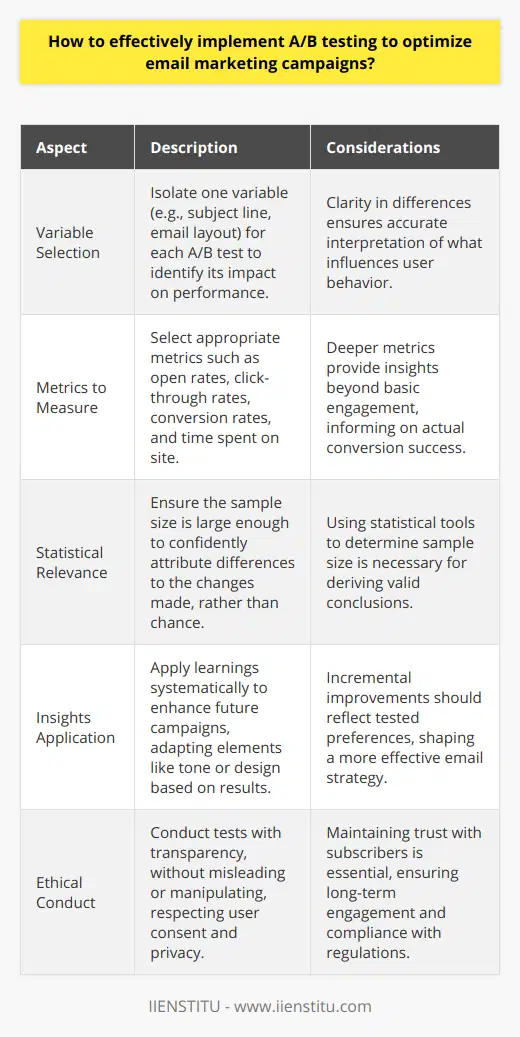
In what ways does utilizing A/B testing within platforms like Mailchimp contribute to successful marketing strategies?
**A/B Testing Applications**
Utilizing A/B testing within platforms like Mailchimp significantly contributes to successful marketing strategies through a variety of applications. Its primary purpose is to evaluate the effectiveness of different marketing tactics based on specific metrics.
**Essential Variables**
A/B testing in Mailchimp allows marketers to experiment with multiple components of their campaigns, such as subject lines, email content, and call-to-action buttons. By comparing these components' performances with different target audiences, marketers can determine which combination yields optimal results.
**Data-Driven Optimization**
Data-driven optimization plays a crucial role in enhancing the effectiveness of marketing campaigns. A/B testing provides marketers with valuable insights into recipient engagement, preferences, and behavior patterns. By analyzing and interpreting the data acquired from A/B testing, marketers can make informed decisions to adjust their strategies, ultimately resulting in higher conversion rates and improved customer satisfaction.
**Personalization and Targeting**
Another way that A/B testing contributes to marketing success is through its ability to segment and target different customer groups. By testing and identifying the preferences of different audience segments, marketers can tailor their content and messaging to better resonate with the recipients. This level of personalization and targeting not only increases the likelihood of engagement but also fosters strong connections between brands and customers.
**Reducing Campaign Risks**
Lastly, A/B testing allows marketers to make informed decisions and validate their strategies before fully implementing them in their campaigns. This process helps reduce the risks and uncertainties associated with marketing initiatives and increases the chances of success by minimizing wasted resources and efforts.
In conclusion, integrating A/B testing within platforms like Mailchimp significantly contributes to successful marketing strategies through data-driven optimization, personalization, targeting, and risk reduction. By employing this approach, marketers can continuously refine their campaigns to maximize the return on investment and achieve their overall marketing objectives.
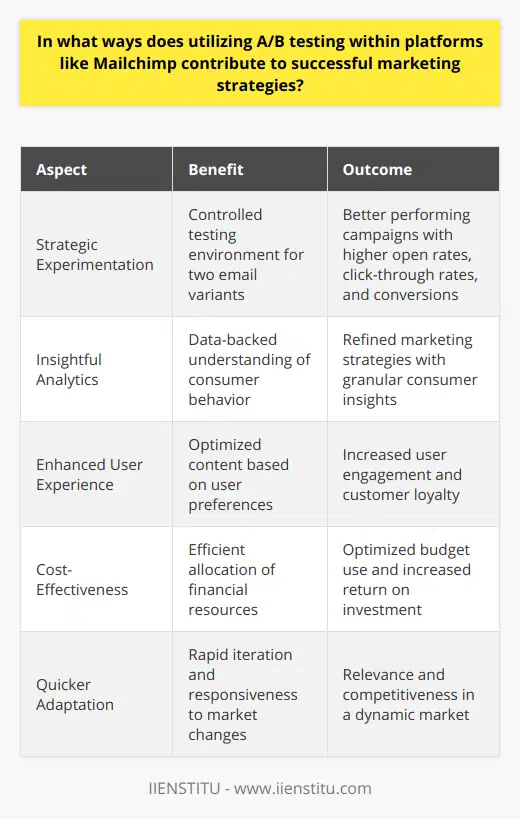
What best practices should be followed while conducting A/B tests for email marketing campaigns?
Establishing Objectives
To achieve accurate results from A/B tests in email marketing campaigns, marketers must first establish clear objectives. These objectives should align with overall business goals and specify the desired outcome, such as improved click-through rates or increased conversions.
Selecting Variables
Next, identify the variables to be tested. Variables may include subject lines, email designs, or call-to-action placements. It is crucial to test one variable at a time to isolate the cause of variations in performance, thus ensuring reliable results.
Sample Size and Test Duration
Appropriate sample sizes and test durations contribute to the validity of A/B test results. Utilize statistical tools, such as sample size calculators, to determine the necessary number of participants for each test group. Additionally, running the test for a sufficient amount of time ensures unbiased results and increased confidence in the data.
Randomization and Control Groups
Randomly assigning recipients to either the test or control group reduces the likelihood of biased data. Implement segmentation tools to create test groups that reflect the overall target population. By doing so, the results become more generalizable to the whole audience.
Statistical Significance
Evaluate the test results based on their statistical significance. This assessment indicates the likelihood that the observed differences between the test and control group results occurred by chance. Opt for a significance level of 95% or greater to maintain confidence in the results.
Continuous Improvement
Finally, ensure continual improvement of email campaigns by iterating on A/B tests. Analyze the data, apply the learnings to future campaigns, and continue to test new variables to maximize the efficiency of email marketing efforts.
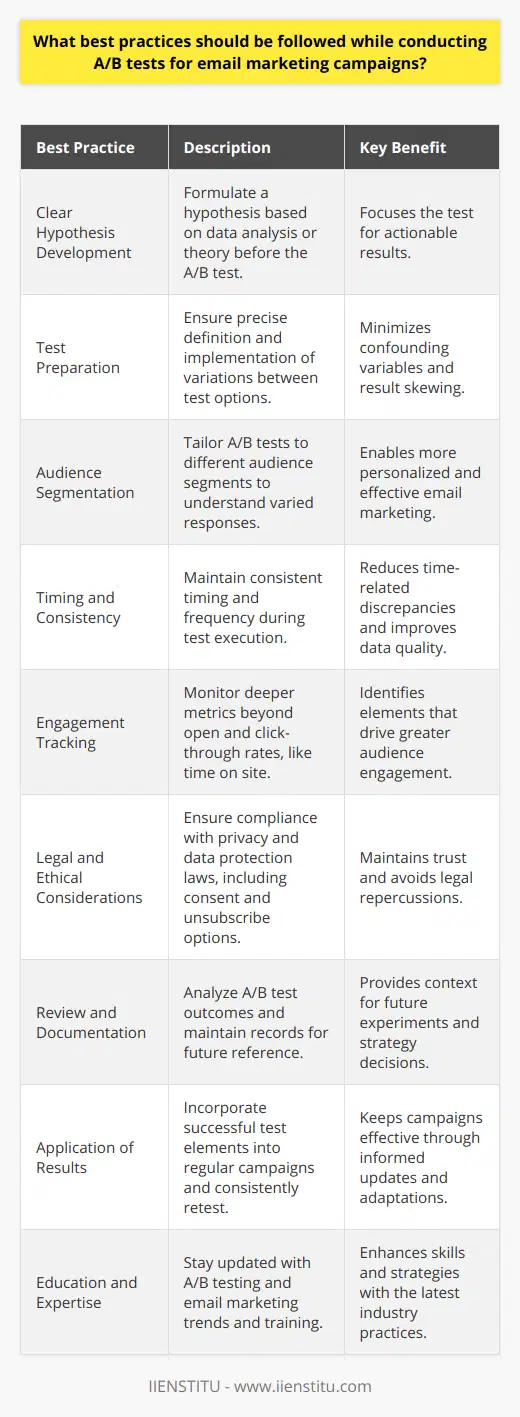
What can you test with your marketing emails using an A/B test?
A/B Testing Strategies for Marketing Emails
Subject Lines Variations
An A/B test on marketing emails can be used to evaluate the effectiveness of different subject lines. By comparing the performance metrics of two or more unique subject lines, marketers can pinpoint which version garners the most opens and engagements, subsequently informing their future email campaigns.
Content Personalization
Another area of focus for A/B tests is personalized content. Sending different content variations to two distinct groups, marketing teams can assess which email attracts more clicks or converts at a higher rate. Such data helps to identify audience preferences and tailor future communications as per their needs.
Visual Design Adjustments
A/B tests in marketing emails may also examine the impact of adjusting specific visual elements, such as featured images, fonts, or layouts, on user engagement. This type of comparison enables marketers to make informed decisions about design components that best resonate with their subscribers, fostering a more striking and effective visual presentation.
Call-to-Action Variations
Investigating the effect of dissimilar call-to-action (CTA) variations on user behaviour is another important aspect of A/B testing. Marketing teams can experiment with various CTA phrases, button designs, and placements to identify the most influential approach that leads to a higher conversion rate.
Send Time Optimization
A/B tests can help discover the ideal email send time by comparing engagement metrics, such as opens and clicks for multiple time slots. By identifying the optimal delivery window, marketers can ensure their email communications reach subscribers at the most receptive moment, maximizing the chances for reader interaction.
In conclusion, A/B testing provides invaluable insights for marketing email strategy optimization, offering opportunities to enhance subject lines, content, design, CTA, and send times. By regularly conducting and applying learnings from these tests, marketing teams can improve their reach and conversion rates, ultimately realizing the full potential of email campaigns.
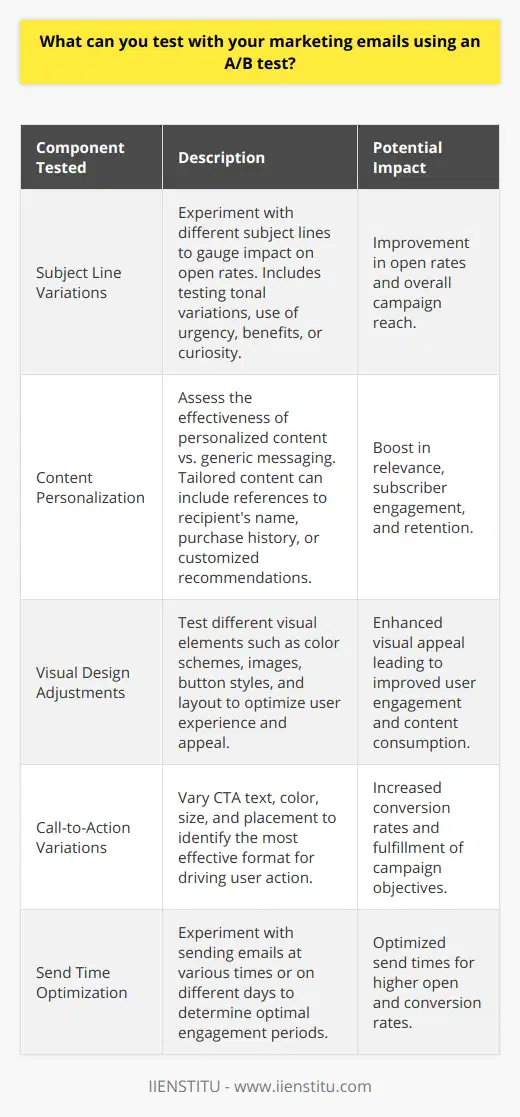
How do I do an A/B test in Mailchimp?
Preparing for the A/B Test
To conduct an A/B test in Mailchimp, start by determining the elements to be tested, such as subject lines, email content, or sender names. Next, decide the sample size and the time period for the test to run, bearing in mind that larger samples and longer time periods yield more reliable results.
Creating Variants
Within Mailchimp, navigate to the Email Campaigns tab and select the 'Create Campaign' button, then opt for 'A/B Test Campaign.' Here, input your campaign's basic information, followed by creating at least two distinct variants for the chosen component to be tested. Ensure that these variants are different enough to accurately measure their impact on performance.
Selecting the Test's Winner
Before launching the test, establish the criteria by which the winning variant will be defined, such as open rate, click rate, or revenue generated. Mailchimp's automation feature can automatically select and send the winning variant to the remaining subscribers at the end of the testing period based on this criterion.
Sending the Test Campaign
With the variants and criteria configured, send your A/B testing campaign to a subset of your list. Make certain that this subset is representative of your entire audience to obtain reliable results. To facilitate this, it may be necessary to segment your list based on relevant characteristics.
Analyzing the Results
Upon the test's completion, Mailchimp provides statistical data for each variant, allowing you to compare their performance and analyze the outcomes. Note that the displayed percentages are calculated in comparison to the control group. Using this data, select the variant that best meets the objective of your initial criteria and implement it in future campaigns.
Iterative Testing
Continuously perform A/B tests on various elements of your email campaigns to optimize their performance. Each test contributes to a greater understanding of your target audience, allowing for more effective campaigns in the long run.
In conclusion, performing A/B tests in Mailchimp is essential in identifying the most effective email campaign elements for improved performance. By following a thorough process of preparation, creation, distribution, and analysis, you can optimize your marketing efforts and maximize your ROI.
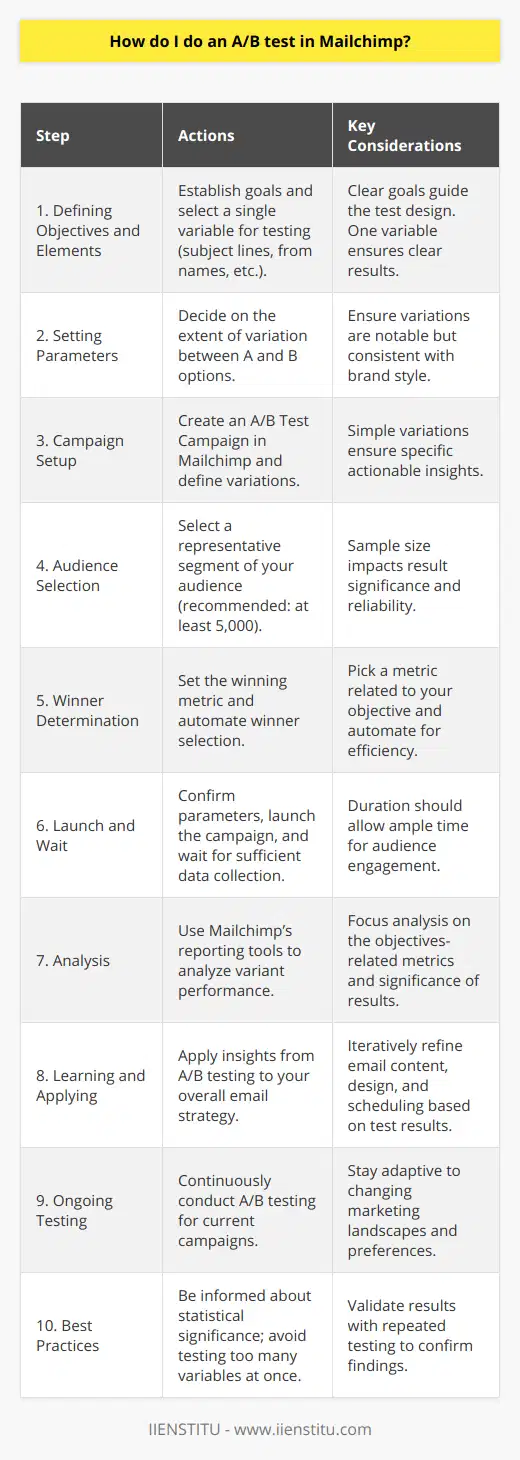
Can you use A/B testing in email campaigns to enhance their effectiveness?
A/B Testing in Email Campaigns
Validity of the Technique
A/B testing can undoubtedly be used in email campaigns to enhance their effectiveness. This scientific method helps compare two variations of a single variable to discover which variation performs better for a given objective. Employing this technique, marketers can optimize various aspects of their campaign to achieve desired outcomes such as open rates, click-through rates, or conversion rates.
Elements to Test
In the context of email campaigns, A/B testing can be applied to aspects such as subject lines, preview text, email content, headlines, call-to-action buttons, visuals, and layout. Experimenting with these elements enables marketers to make data-driven decisions that, in turn, contribute to the campaign's success. For instance, if a marketer aims to increase the open rate, they can test different variations of subject lines to identify which one resonates the most with their target audience.
Sample Size and Duration
For A/B testing to yield accurate results, it is crucial to consider the appropriate sample size and duration. The sample size, consisting of randomly selected recipients, should be large enough to derive statistically significant conclusions. Moreover, the duration of the test should be justifiable based on the marketer's objectives while accounting for external factors that may affect the results.
Data Analysis and Implementation
Upon completion of the test, thorough data analysis should be conducted to understand the performance of both variations across different metrics. Once a clear winner is identified, its best practices can be applied to the entire email campaign to enhance effectiveness. Periodic iterations of A/B tests can be carried out to continually optimize the email campaigns as market dynamics and customer behavior evolve.
In conclusion, A/B testing proves to be a powerful tool in email campaigns to enhance their effectiveness. By testing various elements of the email, selecting appropriate sample size and duration, and analyzing results, marketers can achieve their objectives and optimize their campaigns for maximum impact.
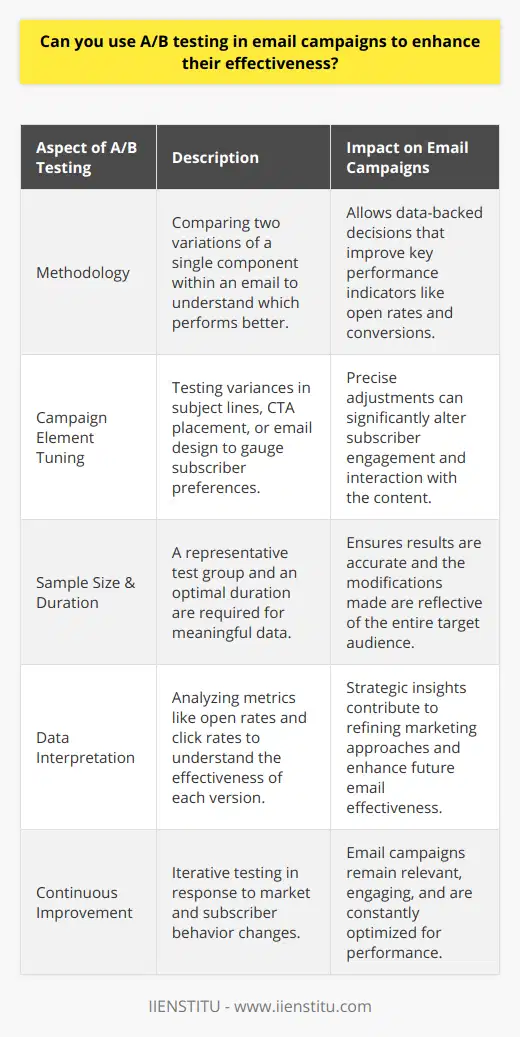
How to design impactful variables when conducting email marketing A/B testing?
Designing Impactful Variables for A/B Testing
The key to impactful A/B testing in email marketing lies in designing influential variables. This process requires a deep understanding of the target audience. Once marketers comprehend the audience, they can develop hypotheses that effectively influence consumer behavior.
Identifying Successful Campaign Elements
Given different recipients will react differently to distinct elements in a campaign, this process of testing includes multiple variables. Deciding what to test depends largely on past successes. Marketers can identify these elements by analyzing successful campaigns and determining which aspects were most impactful.
Selecting Variables for A/B Testing
It is essential, however, to test only one variable at a time. Testing multiple elements simultaneously can make it challenging to attribute successes to any individual attribute. Marketers typically test variables like subject lines, images, colors, and email layouts.
Individual A/B Testing Variables
Subject line testing can involve different sentence structures or formats or emoji usage. Image testing involves utilizing distinct pictures or graphics. Color testing assesses various color schemes, and layout testing may include adjusting text blocks' placement or size.
Measuring the Impact of Variables
The measurement of impact comes through tracking recipients' responses. Emphasizing click-through and open rates will give a clear idea of a variable's effectiveness. It is also crucial to continuously monitor and record data, allowing further optimizations to improve overall campaign performance.
In conclusion, designing impactful variables for A/B testing necessitates a comprehensive understanding of one's audience, meticulous selection of elements to test, and rigorous measurement of results. By adhering to these guidelines, marketers can enhance their email marketing strategies and yield better results.
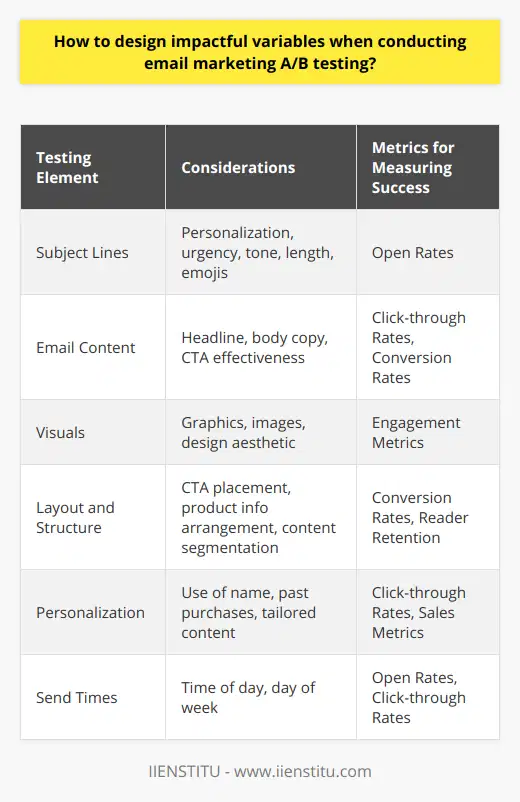
What are the key performance indicators to consider while analyzing the results of an A/B test in email marketing?
Key Performance Indicators for A/B Testing
Open Rate Analysis
Firstly, consider the open rate, which is the percentage of recipients who opened the email. A successful A/B test will typically result in an improvement in open rates.
Click-Through Rate Evaluation
Next, evaluate the click-through rate (CTR), which is the percentage of those who clicked on a link within the email. This demonstrates recipient engagement and indicates the effectiveness of your call-to-action.
Conversion Rate Assessment
The conversion rate assessment, the percentage of email recipients who completed a desired action such as making a purchase or filling out a form, also provides crucial insight.
Bounce Rate Observation
Monitoring the bounce rate, namely the rate at which emails fail to deliver, is crucial. High bounce rates may indicate a problem with your recipient list or email content.
Unsubscribe Rate Review
Finally, the unsubscribe rate, or the percentage of recipients who opt out of future emails, is worth noting. A high unsubscribe rate may highlight issues with email frequency or relevance.
Understanding these key performance indicators in your A/B testing can help better refine your email marketing strategy.
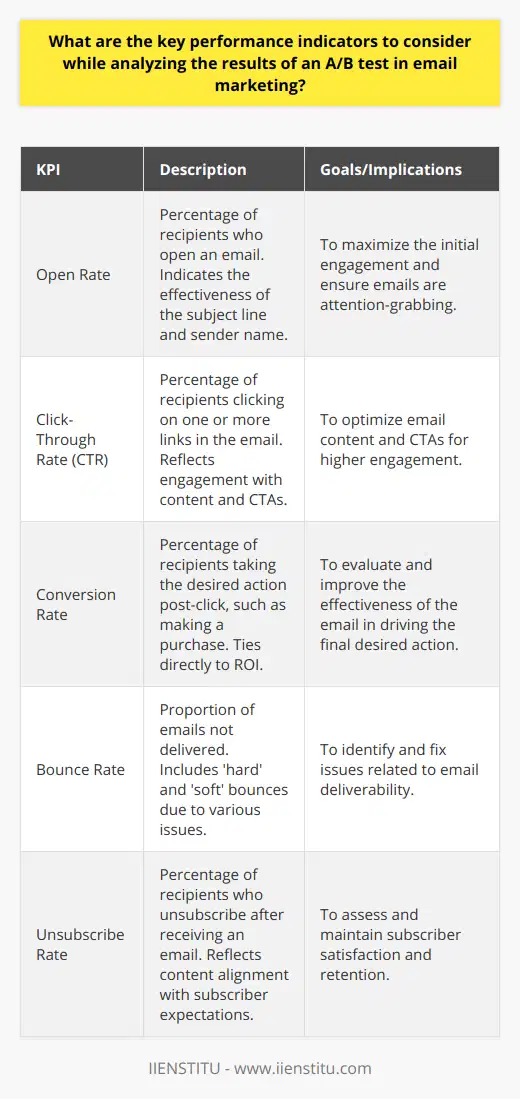
How can A/B testing be employed to determine the ideal sending frequency and timing for email marketing campaigns?
Analyzing Email Frequency through A/B Testing
A/B testing in email marketing offers a strategic way to determine the ideal sending frequency. Marketers create two samples (A and B) with different sending frequencies. They then send the emails to random, equally sized subscriber groups. The email interactions (open rate, click-through rate, and unsubscribe rate) serve as indicators of users' preference for frequency.
Adjusting Timing using A/B Testing
A similar strategy applies to figure out optimal timing. Marketers send similar emails at different times to separate subscriber groups. Through tracking engagement rates (opens and clicks), they can identify which time slots are favorable to the targeted demographic.
Calibrating A/B Testing Setup
Successful A/B testing requires careful planning. The testing period should be long enough to accumulate sufficient data for accurate results. A one-time test might not provide a true reflection due to seasonal variations or user anomalies.
Interpreting Results and Making Adjustments
Once data is obtained, marketers must analyze the results. A higher engagement rate indicates a more effective sending frequency or timing. However, minor differences might be insignificant. Hence, it is crucial to scrutinize the data critically and consider external factors. Adjustment to the campaign should be gradual, after considering average user behavior.
Conclusion
A/B testing is a powerful tool that allows email marketers to optimize sending frequency and timing. However, the success of this strategy heavily depends on proper execution, precise interpretation of results, and careful implementation of changes. With these practices in place, email marketing can be significantly effective in engaging the target audience.



